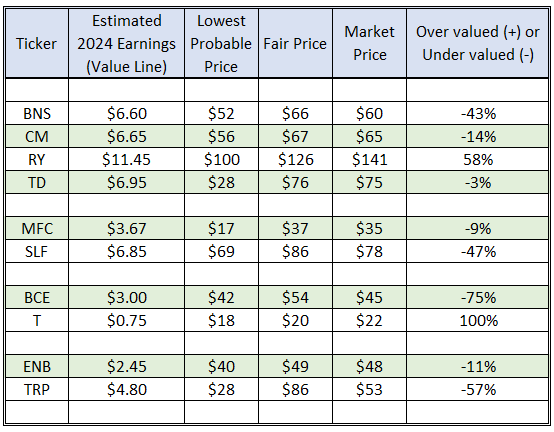
Canadian Dividend Investors
1
When to Buy
Sometimes his (Mr. Market's) idea of value appears plausible and justifed
by business developments and prospects as you know them.
Often, on the other hand, Mr. Market lets his enthusiasm or his fears run away with him,
and the value he proposes seems to you a little short of silly.
1

Benjamin Graham
Benjamin Graham taught his students that to distinguish between the financial value (or fair share price) of the common shares, which is grounded in the earnings of the underlying business, and the market price of the shares, which can be significantly different from the fair share price depending on whether investors are feeling positive or negative about a company's financial prospects.
Professor Graham explained that a useful way of understanding the behaviour of market prices was by imagining the stock market as being an eccentric gentleman called Mr. Market. Each day, Mr. Market offers to buy or sell the shares of the companies listed on the exchange at various prices, and each day you are free to accept or reject his offer.
Usually, the prices he quotes are reasonably close to the fair share prices but occasionally, his prices are considerably higher or lower than the fair share price of some companies. As an investor, you should take advantage of Mr. Market and buy the common shares of one of your favourite companies whenever the price he offers is much lower than the fair share price.
This concept is illustrated graphically for Sun Life in the following figure, in which the highest probable market price, the lowest probable market price and the fair share price are shown, along with the current market price, which in this example is lower than the fair share price:

You can maximize your dividend income by buying the common shares of financially stable companies when the market price of the shares falls well below the fair share price. The degree by which Mr. Market is undervaluing the shares, with respect to the fair price, can be calculated using the following equation:
..........................................(1)

Based on this equation, when the market price of Sun Life is equal to the fair share price, the degree of undervaluation of the shares would be 0%. If the market price of Sun Life were to fall to its lowest probable price ($69), the degree of undervaluation would be minus 100%, while if the market price rises to the highest probable price ($103), then the degree of overvaluation would be plus 100%.
I suggest that you determine the highest and lowest probable market prices and the fair share prices of all the companies on your watchlist (or in your portfolio) and put them in a spreadsheet, such as MS Excel, as illustrated in the following table. Every few weeks you can insert the most recent market prices into your spreadsheet, so that it will automatically calculate the degree of over or undervaluation of each company in your watchlist.
As shown in Table 8, Mr. Market appeared to be undervaluing the shares of BNS, SLF, BCE and TRP by 43%, 47%, 75% and 57%, respectively on that particular trading day. Before you decide to purchase one of these undervalued businesses, you should review the cause of the sudden drop in the market price and determine whether or not the event that caused the drop will affect the company's long term financial success, and therefore your estimated fair share price.
It is important to understand that once you have purchased the shares, the cash dividend you receive will never change unless management decides to increase or decrease the dividend. For example, if the market price falls after you buy the shares, the dividend yield (based on the market price) will rise, from 5.0% to say 5.5%, but the cash dividend payment you receive will remain the same as before the market price fell.

Keep in mind that you are buying one of your favourite companies, such as Sun Life Financial, not because you expect the market price to rise in the next few months, but because you expect the company to pay you a significant and growing dividend income for the next several decades. Once you own all the shares you want of each of your favourite companies, you can ignore future changes in their market prices because they have no effect on your dividend income. You can (and should) focus all of your attention on the businesses you hold and the safety of their growing dividends.
1. Graham, B., 1973. The Intelligent Investor, The Definitive Book on Value Investing, 4th Ed., Updated in 2003 with new commentary by Jason Zweig. HarperCollins Publishers, 10 East 53rd Street, New York, NY p. 205